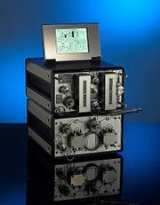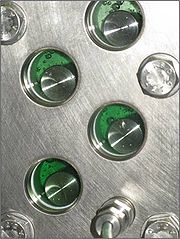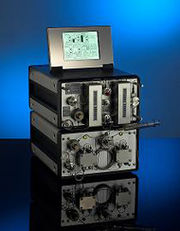
Flow chemistry
Encyclopedia
In flow chemistry, a chemical reaction
is run in a continuously flowing stream rather than in batch production
. In other words, pumps move fluid into a tube, and where tubes join one another, the fluids contact one another. If these fluids are reactive, a reaction takes place. Flow chemistry is a well-established technique for use at a large scale when manufacturing
large quantities of a given material. However, it is relatively new to use it in the laboratory
environment.
 Continuous reactors
Continuous reactors
are typically tube like and manufactured from non-reactive materials such as stainless steel, glass and polymers. Mixing methods include diffusion
alone (if the diameter of the reactor is small e.g. <1 mm) and static mixers.
Continuous flow reactors allow good control over reaction conditions including heat transfer, time and mixing.
The residence time of the reagents in the reactor (i.e. the amount of time that the reaction is heated or cooled) is calculated from the volume of the reactor and the flow rate through it.
Residence time = Reactor Volume / Flow Rate
Therefore, to achieve a longer residence time, reagents can be pumped more slowly and/or a larger volume reactor used. Production rates can vary from nano litres to litres per minute.
Some examples of flow reactors are spinning disc reactors (Colin Ramshaw); spinning tube reactors; multi-cell flow reactors; oscillatory flow reactors; microreactors; hex reactors; and 'aspirator reactors'.
In an aspirator reactor a pump propels one reagent, which causes a reactant to be sucked in. This type of reactor was patented circa 1941 by Nobel companies for used in preparing nitroglycerin.
efficiency benefits from improved thermal
and mass transfer
as well as mass transport.

and Carbonylation, although work has also been performed using other gases, from ethylene
to ozone
.
Reasons for the suitability of flow systems for hazardous gas handling are:
In continuous flow, experiments are performed serially, which means only one experimental condition can populate the reactor tube at any given time. Experimental throughput is highly variable and is dependent upon the reactor volume and residence time (flow rate).
Segmented flow is an approach that improves upon the speed in which screening, optimization and libraries can be conducted in flow chemistry. Segmented flow uses a "Plug Flow
" approach where specific volumetric experimental mixtures are created and then injected into a high pressure flow reactor. Diffusion of the segment (reaction mixture) is minimized by using immiscible solvent on the leading and rear ends of the segment.
One of the primary benefits of segmented flow chemistry is the ability to run experiments in a serial/parallel manner where experiments that share the same residence time and temperature can be repeatedly created and injected. In addition, the volume of each experiment is independent to that of the volume of the flow tube thereby saving a significant amount of reactant per experiment. When performing reaction screening and libraries, segment composition is typically varied by composition of matter. When performing reaction optimization, segments vary by stoichiometry.
Segmented flow is also used with online LCMS, both analytical and preparative where the segments are detected when exiting the reactor using UV and subsequently diluted for analytical LCMS or injected directly for preparative LCMS.
discussing the current state of the art and highlighting recent progress and current challenges facing the emerging area of continuous flow techniques for multi-step synthesis. Published by the Royal Society of Chemistry
Chemical reaction
A chemical reaction is a process that leads to the transformation of one set of chemical substances to another. Chemical reactions can be either spontaneous, requiring no input of energy, or non-spontaneous, typically following the input of some type of energy, such as heat, light or electricity...
is run in a continuously flowing stream rather than in batch production
Batch production
Batch production is a technique used in manufacturing, in which the object in question is created stage by stage over a series of workstations. Batch production is common in bakeries and in the manufacture of sports shoes, pharmaceutical ingredients , inks, paints and adhesives. In the manufacture...
. In other words, pumps move fluid into a tube, and where tubes join one another, the fluids contact one another. If these fluids are reactive, a reaction takes place. Flow chemistry is a well-established technique for use at a large scale when manufacturing
Manufacturing
Manufacturing is the use of machines, tools and labor to produce goods for use or sale. The term may refer to a range of human activity, from handicraft to high tech, but is most commonly applied to industrial production, in which raw materials are transformed into finished goods on a large scale...
large quantities of a given material. However, it is relatively new to use it in the laboratory
Laboratory
A laboratory is a facility that provides controlled conditions in which scientific research, experiments, and measurement may be performed. The title of laboratory is also used for certain other facilities where the processes or equipment used are similar to those in scientific laboratories...
environment.
Batch vs. flow
Comparing parameters in Batch vs Flow:- Reaction stoichiometry. In batch production this is defined by the concentration of chemical reagents and their volumetric ratioRatioIn mathematics, a ratio is a relationship between two numbers of the same kind , usually expressed as "a to b" or a:b, sometimes expressed arithmetically as a dimensionless quotient of the two which explicitly indicates how many times the first number contains the second In mathematics, a ratio is...
. In Flow this is defined by the concentrationConcentrationIn chemistry, concentration is defined as the abundance of a constituent divided by the total volume of a mixture. Four types can be distinguished: mass concentration, molar concentration, number concentration, and volume concentration...
of reagents and the ratio of their flow rate. - Residence time. In batch production this is determined by how long a vessel is held at a given temperature. In flow this is determined by the volume of the reactor, and the bulk flow rate.
Benefits of flow
- Reaction temperature can be far above the solvent's boiling pointBoiling pointThe boiling point of an element or a substance is the temperature at which the vapor pressure of the liquid equals the environmental pressure surrounding the liquid....
due to easy ability to contain pressurePressurePressure is the force per unit area applied in a direction perpendicular to the surface of an object. Gauge pressure is the pressure relative to the local atmospheric or ambient pressure.- Definition :...
. - Mixing can be achieved within seconds at the smaller scales used in flow chemistry.
- The thermal mass of the fluid is typically far lower than the thermal mass of the system (and orders of magnitude less than with batch chemistry). This makes controlling the temperature of the media both faster and easier ensuring that exothermic and endothermic process can be conducted without issue.
- Multi step reactions can be arranged in a continuous sequence. This can be especially beneficial if intermediate compounds are unstable, since they will exist only momentarily and in very small quantities.
- Position along the flowing stream and reaction time point are directly related to one another. This means that it is possible to arrange the system such that further reagents can be introduced into the flowing reaction stream at precisely the time point in the reaction that is desired.
- It is possible to arrange a flowing system such that purification is coupled with the reaction. There are three primary techniques that are used:
- Solid phase scavenging
- Chromatographic separation
- Liquid/Liquid Extraction
- By coupling the output of the reactor to a detector system, it is possible with appropriate controls to create an unattended system which can sequentially investigate a range of possible reaction parameters (varying stoichiometry, residence time and temperature) and therefore optimise reactions with little or no intervention.
- Reactions which involve reagents containing dissolved gases are easily handled, whereas in batch a pressurised "bomb" reactor would be necessary.
- Multi phase liquid reactions (e.g. phase transfer catalysis) can be performed in a straightforward way, with high reproducibility over a range of scales and conditions.
- Scaleup of a proven reaction can be achieved rapidly with little or no process development work, by either changing the reactor volume or by running several reactors in parallel, provided that flows are recalculated to achieve the same residence times.
Continuous flow reactor

Continuous reactors
Continuous reactors carry material as a flowing stream. Reactants are continuously fed into the reactor and emerge as continuous stream of product. Continuous reactors are used for a wide variety of chemical and biological processes within the food, chemical and pharmaceutical industries...
are typically tube like and manufactured from non-reactive materials such as stainless steel, glass and polymers. Mixing methods include diffusion
Diffusion
Molecular diffusion, often called simply diffusion, is the thermal motion of all particles at temperatures above absolute zero. The rate of this movement is a function of temperature, viscosity of the fluid and the size of the particles...
alone (if the diameter of the reactor is small e.g. <1 mm) and static mixers.
Continuous flow reactors allow good control over reaction conditions including heat transfer, time and mixing.
The residence time of the reagents in the reactor (i.e. the amount of time that the reaction is heated or cooled) is calculated from the volume of the reactor and the flow rate through it.
Residence time = Reactor Volume / Flow Rate
Therefore, to achieve a longer residence time, reagents can be pumped more slowly and/or a larger volume reactor used. Production rates can vary from nano litres to litres per minute.
Some examples of flow reactors are spinning disc reactors (Colin Ramshaw); spinning tube reactors; multi-cell flow reactors; oscillatory flow reactors; microreactors; hex reactors; and 'aspirator reactors'.
In an aspirator reactor a pump propels one reagent, which causes a reactant to be sucked in. This type of reactor was patented circa 1941 by Nobel companies for used in preparing nitroglycerin.
Flow reactor scale
The smaller scale of micro flow reactors can make them ideal for process development experiments. Although it is possible to operate flow processes at a Tonne plus scale, syntheticChemical synthesis
In chemistry, chemical synthesis is purposeful execution of chemical reactions to get a product, or several products. This happens by physical and chemical manipulations usually involving one or more reactions...
efficiency benefits from improved thermal
Thermal transfer
In regards to printing a thermal transfer is when a specialized printer melts wax within its print-heads and uses it to print a design or text onto paper...
and mass transfer
Mass transfer
Mass transfer is the net movement of mass from one location, usually meaning a stream, phase, fraction or component, to another. Mass transfer occurs in many processes, such as absorption, evaporation, adsorption, drying, precipitation, membrane filtration, and distillation. Mass transfer is used...
as well as mass transport.

Use of gases in flow
Laboratory scale flow reactors are ideal systems for using gases, particularly those that are toxic or associated with other hazards. The gas reactions that have been most successfully adapted to flow are HydrogenationHydrogenation
Hydrogenation, to treat with hydrogen, also a form of chemical reduction, is a chemical reaction between molecular hydrogen and another compound or element, usually in the presence of a catalyst. The process is commonly employed to reduce or saturate organic compounds. Hydrogenation typically...
and Carbonylation, although work has also been performed using other gases, from ethylene
Ethylene
Ethylene is a gaseous organic compound with the formula . It is the simplest alkene . Because it contains a carbon-carbon double bond, ethylene is classified as an unsaturated hydrocarbon. Ethylene is widely used in industry and is also a plant hormone...
to ozone
Ozone
Ozone , or trioxygen, is a triatomic molecule, consisting of three oxygen atoms. It is an allotrope of oxygen that is much less stable than the diatomic allotrope...
.
Reasons for the suitability of flow systems for hazardous gas handling are:
- Systems allow the use of a fixed bed catalyst. Combined with low solution concentrations, this allows all compound to be adsorbed to catalyst in the presence of gas
- Comparatively small amounts of gas are continually exhausted by the system, eliminating the need for many of the special precautions normally required for handling toxic and/or flammable gases
- The addition of pressure means that a far greater proportion of the gas will be in solution during the reaction than is the case conventionally
- The greatly enhanced mixing of the solid, liquid and gaseous phases allows the researcher to exploit the kinetic benefits of elevated temperatures without being concerned about the gas being displaced from solution
Other uses of flow
It is possible to run experiments in flow using more sophisticated techniques, such as solid phase chemistries.Scale up of microwave reactions
Microwave reactors are frequently used for small scale batch chemistry. However due to the extremes of temperature and pressure reached in a microwave it is often difficult to transfer these reactions to conventional non-microwave apparatus for subsequent development, leading to difficulties with scaling studies. A flow reactor with suitable high temperature ability and pressure control can directly and accurately mimic the conditions created in a microwave reactor, and since in flow chemistry the quantity of material produced is limited only by the reaction time, scaling can be achieved.Segmented Flow Chemistry
As discussed above, running experiments in continuous flow systems is difficult, especially when one is developing new chemical reactions, which requires screening of multiple components, varying stoichiometry, temperature and incubation time (flow rate).In continuous flow, experiments are performed serially, which means only one experimental condition can populate the reactor tube at any given time. Experimental throughput is highly variable and is dependent upon the reactor volume and residence time (flow rate).
Segmented flow is an approach that improves upon the speed in which screening, optimization and libraries can be conducted in flow chemistry. Segmented flow uses a "Plug Flow
Plug flow reactor model
The plug flow reactor model is used to describe chemical reactions in continuous, flowing systems. The PFR model is used to predict the behaviour of chemical reactors, so that key reactor variables, such as the dimensions of the reactor, can be estimated...
" approach where specific volumetric experimental mixtures are created and then injected into a high pressure flow reactor. Diffusion of the segment (reaction mixture) is minimized by using immiscible solvent on the leading and rear ends of the segment.
One of the primary benefits of segmented flow chemistry is the ability to run experiments in a serial/parallel manner where experiments that share the same residence time and temperature can be repeatedly created and injected. In addition, the volume of each experiment is independent to that of the volume of the flow tube thereby saving a significant amount of reactant per experiment. When performing reaction screening and libraries, segment composition is typically varied by composition of matter. When performing reaction optimization, segments vary by stoichiometry.
Segmented flow is also used with online LCMS, both analytical and preparative where the segments are detected when exiting the reactor using UV and subsequently diluted for analytical LCMS or injected directly for preparative LCMS.
External links
Continuous flow multi-step organic synthesis - a Chemical Science Mini Review by Damien Webb and Timothy F. Jamisondiscussing the current state of the art and highlighting recent progress and current challenges facing the emerging area of continuous flow techniques for multi-step synthesis. Published by the Royal Society of Chemistry
Royal Society of Chemistry
The Royal Society of Chemistry is a learned society in the United Kingdom with the goal of "advancing the chemical sciences." It was formed in 1980 from the merger of the Chemical Society, the Royal Institute of Chemistry, the Faraday Society and the Society for Analytical Chemistry with a new...

